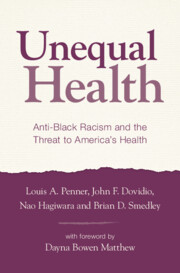Book contents
- Unequal Health
- Unequal Health
- Copyright page
- Dedication
- Endorsements
- Contents
- Figures
- Tables
- Foreword
- Prologue
- Acknowledgments
- Introduction
- Chapter 1 The Past Is Prologue
- Chapter 2 A Threat to the Common Good
- Chapter 3 “Two Americas”
- Chapter 4 Racism in American Medicine
- Chapter 5 Not Part of the Solution
- Chapter 6 A Dangerous Foot in the Door
- Chapter 7 Paths to a Solution
- Index
- References
Chapter 2 - A Threat to the Common Good
Racism and the Health of Black Americans
Published online by Cambridge University Press: 07 September 2023
- Unequal Health
- Unequal Health
- Copyright page
- Dedication
- Endorsements
- Contents
- Figures
- Tables
- Foreword
- Prologue
- Acknowledgments
- Introduction
- Chapter 1 The Past Is Prologue
- Chapter 2 A Threat to the Common Good
- Chapter 3 “Two Americas”
- Chapter 4 Racism in American Medicine
- Chapter 5 Not Part of the Solution
- Chapter 6 A Dangerous Foot in the Door
- Chapter 7 Paths to a Solution
- Index
- References
Summary
This chapter discusses the direct effects of racial discrimination on Black Americans’ health. It begins by documenting that daily exposure to the various forms of racial discrimination is a common experience for Black people living in the United States. Encountering racial discrimination creates stress, which activates physiological stress responses – bodily systems that normally provide person with the energy needed to rapidly reduce the stress. However, the stress created by racial discrimination is usually chronic because many Black Americans repeatedly experience racial discrimination over a prolonged period of time. When the bodily systems activated by stress response remain active, it creates a harmful physical condition – allostatic overload. Allostatic overload is responsible for a host of physical illnesses, including heart diseases, diabetes, and immune disorders. It is also associated with poorer mental health, as well as alterations in epigenetics, such as premature aging. Chronic stress can also cause people to engage in behaviors that may provide short-term emotional relief from discrimination-related stress but are unhealthy, such as drug use or eating certain unhealthy “comfort” foods. In sum, prolonged exposure to racial discrimination is a chronic stressor that threatens the health of Black Americans.
Keywords
- Type
- Chapter
- Information
- Unequal HealthAnti-Black Racism and the Threat to America's Health, pp. 80 - 123Publisher: Cambridge University PressPrint publication year: 2023

